One of the first symptoms people with chronic kidney disease may experience is a drop in energy. This can be a sign that anemia has developed; one of the most common effects of CKD. Eating iron-rich foods is a great way for CKD patients to keep anemia from worsening. In this article, we’ll be reviewing the iron-rich foods that can be incorporated into a renal diet for CKD patients. You’ll also be able to download a free printable iron-rich foods list below.
Don’t miss out on the anemia diet plan included at the end of this article. It may give you insight into how easy it can be for CKD patients like you to get iron-rich foods into your diet.
*This article contains affiliate links in which I will make a small percentage on items featured, at no expense to you. I only recommend products that I truly believe in and use myself or recommend to clients. As an Amazon affiliate, I earn from qualifying purchases. Thank you for your support!
Table of Contents
Anemia
Anemia is when the body does not have enough red blood cells.
This creates a deficiency in delivering oxygen and nutrients throughout the body.
It can be very important to get enough oxygen throughout the body, especially for those with kidney disease.
The kidneys need oxygen to do their jobs.
Additionally, anemia is one of the most common complications of kidney disease.
Symptoms of Anemia
Often, people with anemia can experience;
- Low energy levels
- Decreased appetite
- Headaches
- Difficulty concentrating
- Shortness of breath
Your nephrologist and health team will track your hemoglobin (red blood cell) levels in your blood results.
If left untreated, this can lead to further problems with the heart, including heart failure.
Hemoglobin
Hemoglobin is a protein in the blood. It carries oxygen around to organs and cells.
Hemoglobin levels for healthy individuals should be between 14 – 18 g/dL for men and 12.0 – 16 g/dL for women.
For those with kidney disease, hemoglobin levels may start to drop.
In dialysis, the goal for hemoglobin is 10-11 g/dL.
This is typically measured weekly in hemodialysis and monthly in peritoneal dialysis.
Medications are then adjusted as needed by the dialysis team.
Iron and Kidneys
Iron is a mineral. It is used in the body to help with growth and development, including making our DNA.
Iron is also a part of hemoglobin.
Iron is also used to make myoglobin. The role of myoglobin is to help with getting oxygen to the muscles.
Iron in Blood Test Results
Your doctor may check your iron levels. This can include;
- serum iron
- transferrin
- TIBC
- UIBC
- serum ferritin
You can learn more about these in our Stage 4 Kidney Disease Guide.
Recommended Daily Amount of Iron
The Recommended Daily Allowance (RDA) of iron is as follows.
| Age and life cycle | RDA for Iron |
|---|---|
| Men (ages 19 to 50+) | 8 mg/day |
| Women (ages 15 to 50) | 18 mg/day |
| Pregnant Women | 27 mg/day |
| Postmenopausal Women | 8 mg/day |
The Tolerable Upper Intake Limit (UL) is 45 mg/day.
Taking in more iron than this can cause gastrointestinal distress.
Is Iron Good for My Kidneys?
As mentioned, iron is very important for the body.
And with kidney disease, some people may not get enough iron.
In these cases, a doctor will prescribe iron supplements.
However, this does not mean that everyone with kidney issues should take iron supplements.
People with kidney issues, especially those on dialysis, can develop hemochromatosis.
This is when there is too much iron in the blood.
One of the functions of our kidneys is to create red blood cells.
When someone has kidney disease, they may not be able to make enough red blood cells.
This is how many people with chronic kidney disease can develop anemia.
Types of Iron in the Diet
When it comes to adding iron-rich foods to your diet, it’s important to know the different types of iron available.
Heme Iron
The most common type of iron is heme iron. This one is most absorbable by the body.
The amount of heme iron absorbed from food is approximately 15% to 35%.
Heme iron is found in animal products including meat, seafood, and eggs.
Non-Heme Iron
The second type of iron is non-heme iron.
This iron is found in plants including fruits, vegetables, grains, and even spices.
Meats and animal products can also have non-heme iron as well as heme iron.
Non-heme iron is less absorbed than heme iron, between 2% and 20%.
However, it contributes to more iron in the body because there are many sources of non-heme iron in the diet.
Iron-Rich Foods for CKD patients
There are a lot of iron-rich foods that are good for CKD patients to enjoy as part of the renal diet.
Since everyone has different diet needs, this is a complete list of iron-rich foods.
There may be certain foods or food groups that aren’t for you.
For example, if you are on a low protein diet, you may not be eating meat, seafood, or eggs.
Feel free to skip that section and move into the vegan iron-rich foods that can still be a great source of iron.
Meats
As mentioned, animal meats and meat products will have the highest amount of heme iron available.
This is because animals, like us, also have iron in their body.
| Food | milligrams (mg) of iron in 100 grams |
|---|---|
| Beef, tenderloin | 3 mg |
| Beef, ground (90% lean) | 2 mg |
| Beef, T-bone steak | 3 mg |
| Lamb | 1 mg |
| Chicken, skinless boneless breast | <1 mg |
| Turkey, ground (93% lean) | 1 mg |
| Pork, tenderloin | 1 mg |
| Veal | 1 mg |
| Liverwurst | 6 mg |
Seafood
Seafood, also animal meat products, can be iron-rich as well.
Some iron-rich seafood are listed in the table below.
| Food | milligrams (mg) of iron in 100 grams |
|---|---|
| Tuna (canned) | 1 mg |
| Tuna (bluefin) | 1 mg |
| Sardines | 3 mg |
| Mackerel | 1 mg |
| Shrimp | 0.5 mg |
| Scallops | 0.5 mg |
| Oysters (canned) | 6 mg |
| Clams (cooked) | 3 mg |
Eggs
Eggs are surprisingly high in iron (as well as protein).
One large egg will give you 0.8 mg of iron.
If you stick to egg whites for a low phosphorus diet, you will not get the iron.
Iron is stored in the egg yolk, along with other nutrients like B vitamins.
Vegetables
While animal meats are a good source of iron, there are great plant-based sources too.
Adding more vegetables to a renal diet provides plenty of other benefits.
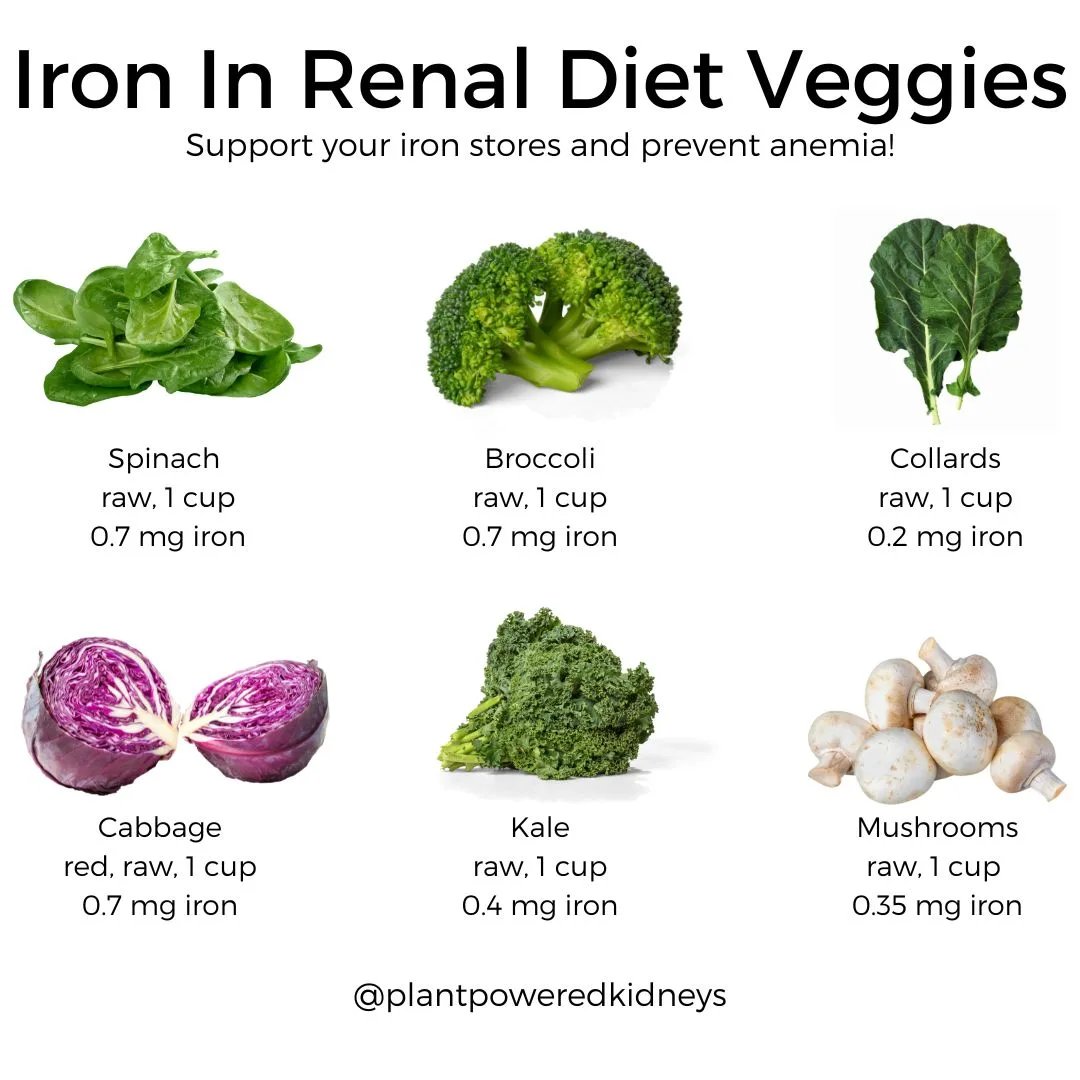
Some vegetables that also have iron include;
| Food | milligrams (mg) of iron in 100 grams |
|---|---|
| Spinach | 1.3 mg |
| Broccoli | 0.73 mg |
| String Beans | 0.86 mg |
| Collards | 0.47 mg |
| Cabbage | 0.8 mg |
| Brussels Sprouts | 1.4 mg |
| Kale | 1.6 mg |
| Swiss Chard | 1.8 mg |
| Mushrooms | 0.5 mg |
| Peas | 1.47 mg |
| Sweet Potatoes | 0.69 mg |
| Tomato Sauce | 0.96 mg |
| Seaweed | 2.85 mg |
| Spirulina | 28.5 mg |
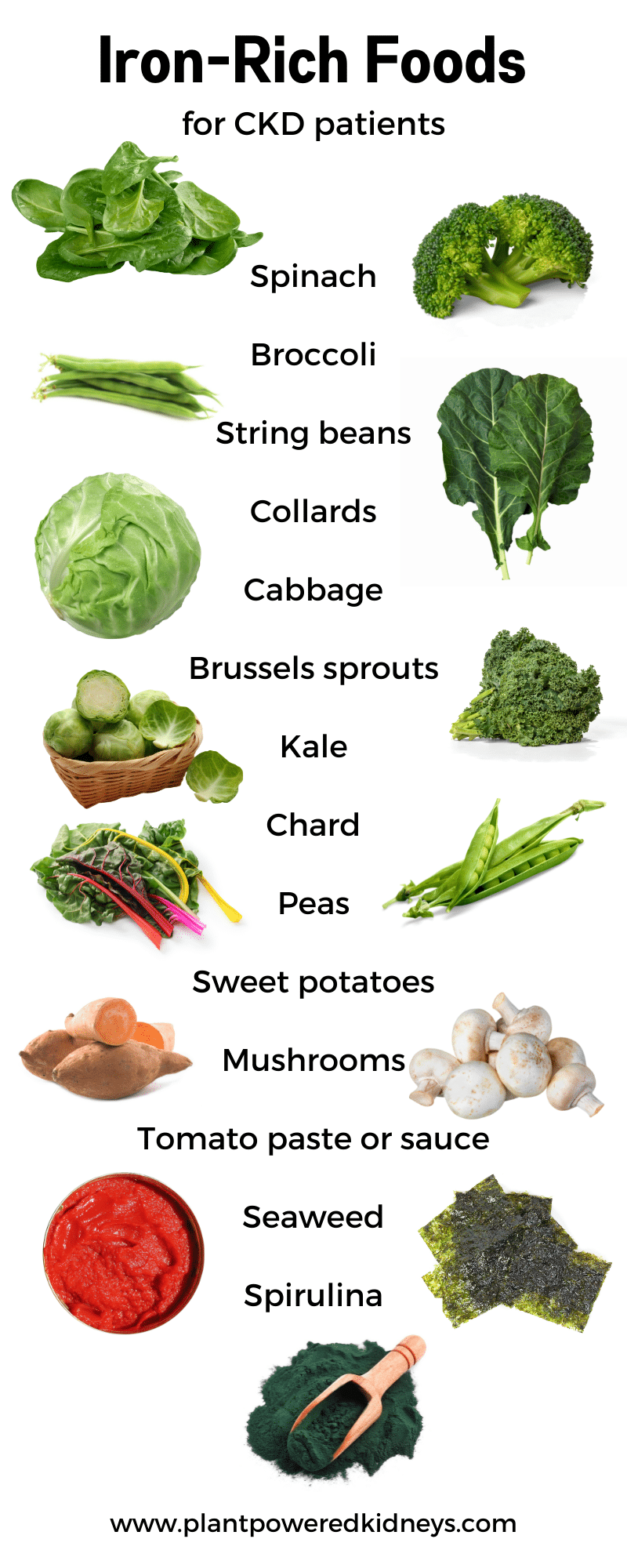
Fruits
Even fruits can be a source of iron-rich foods.
And for CKD patients following a renal diet, fruits should be included as well.
Fruits that are a good source of iron are generally dried.
| Food | milligrams (mg) of iron in 100 grams |
|---|---|
| Raisins | 1.79 mg |
| Figs (dried) | 2.03 mg |
| Dates (medjool) | 0.9 mg |
| Apricots (dried) | 2.66 mg |
| Peaches (dried) | 4.06 mg |
| Prunes | 0.93 mg |
| Watermelon | 0.24 mg |
| Mulberries (raw) | 1.85 mg |
| Olives | 6.28 mg |
That being said, there are some fresh fruits that still have iron as well.
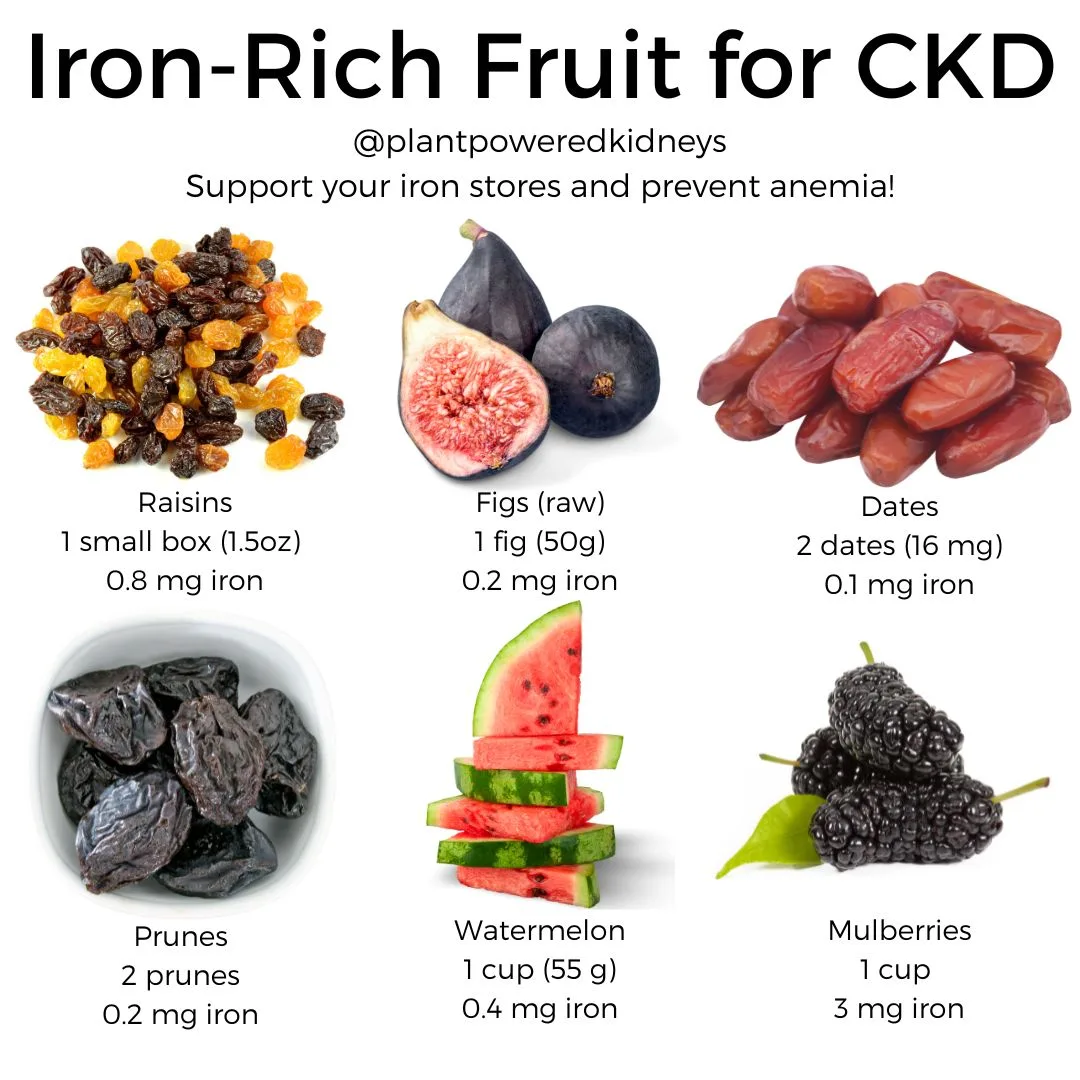
Keep in mind that dried fruits are also high in potassium.
Keep portions and frequency in mind if adding dried fruits.
If you need to limit potassium, dried fruits should be limited or avoided.
Beans & Legumes
Bean and legumes are a great part of a renal diet for CKD patients.
Packed with plant-based protein, fiber, and tons of other vitamins and minerals, everyone can find an option to enjoy here.
| Food | milligrams (mg) of iron in 100 grams |
|---|---|
| Tofu (extra firm) | 2.04 mg |
| Tempeh | 2.7 mg |
| Soybeans (raw) | 3.55 mg |
| Lentils (cooked) | 3.33 mg |
| Kidney beans | 2.94 mg |
| Navy beans | 2.36 mg |
| Chickpeas | 2.89 mg |
| Black-eyed peas | 1.54 mg |
| Peanuts | 1.55 mg |
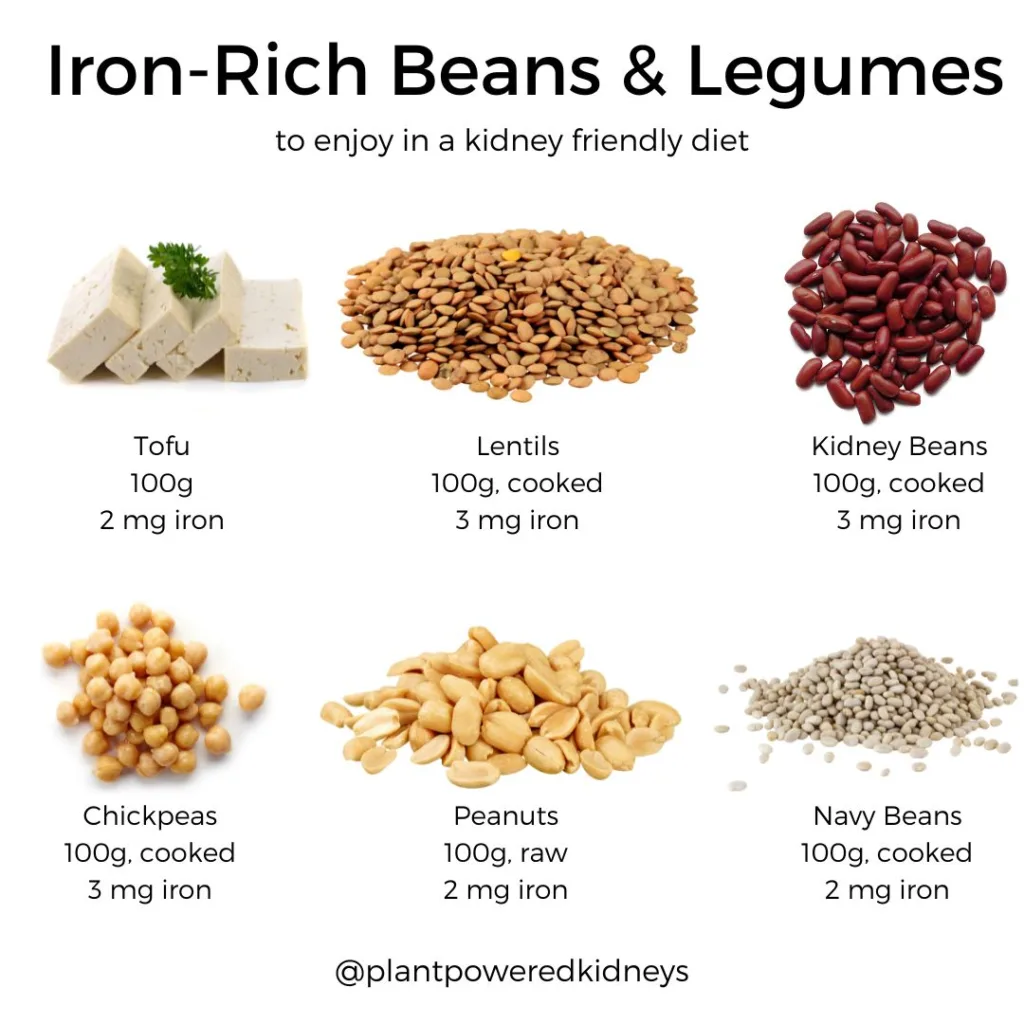
Nuts & Seeds
While many worry about the phosphorus in nuts and seeds, it’s actually something that can be included.
The key is to identify the smaller portion size.
Nuts and seeds are also packed with tons of nutrients, and a little goes a long way.
There are a good variety of nuts and seeds that also have non-heme iron.
Here is a table of iron-rich nuts and seeds for CKD patients.
| Food | milligrams (mg) of iron in 100 grams |
|---|---|
| Pumpkin Seeds | 8.36 mg |
| Sesame Seeds | 6.36 mg |
| Hemp Seeds | 7.95 mg |
| Flaxseed (ground) | 5.78 mg |
| Almonds | 3.74 mg |
| Cashews | 5.99 mg |
| Pine Nuts | 5.36 mg |
| Macadamia Nuts | 1.88 mg |
| Pecans | 2.37 mg |
| Walnuts | 2.24 mg |
| Pistachios | 3.46 mg |
| Sunflower Seeds | 5.21 mg |
In general, a serving of nuts is 1 ounce.
A serving of seeds is 2 tablespoons.
Bread, Grains, and Cereals
Interestingly enough, the group of grains can be a great source of iron.
This is because many grain products are fortified with iron and other nutrients.
Grains that are a good source of iron include;
- Fortified/enriched rice
- Fortified/enriched cereals (both hot and cold)
- Pasta
- Amaranth
- Spelt
- Teff
- Freekeh
- Barley
- Fonio
- Oats
- Quinoa
Learn more about bread in a renal diet here.
Herbs and Spices
Yes, even herbs and spices have iron in them.
Not only will you be giving your meals a boost of iron, but by swapping out some salt for spices, you can help your kidneys by following a lower sodium diet.
Some spices that include iron are;
- Thyme
- Basil
- Spearmint
- Marjoram
- Cumin
- Turmeric
- Dill
- Celery
- Bay leaves
- Coriander
- Savory
- Anise seed
- Oregano
- Tarragon
- Rosemary
- Sage
Each of these will provide approximately 0.2 – 0.5 mg per teaspoon dried.
Thyme, however, will provide a whopping 1.2 mg per teaspoon of dried leaves.
Try adding it to a sheet pan of roasted veggies.
Other iron-rich foods
There are some other foods that must be mentioned here, too.
Even condiments can have iron.
Here are some foods that you can add to your diet for more iron;
- Blackstrap molasses
- Coconut milk
- Dark chocolate
Chocolate is another one of those items that, when limited, can provide benefits without the risks.
If you eat too much, though, you may see higher phosphorus levels in your blood test results.
Printable Iron-Rich Foods List
There is a lot of information here, including all the foods that are iron-rich.
You can get all this information for free, right now.
Tips to Increase Iron Absorption
There are a few things you can do to help make the most of your iron-rich foods.
Pair with vitamin C-rich foods
By adding foods high in vitamin C, you’ll be increasing the absorption of iron.
Adding vitamin C-rich foods with non-heme iron foods may increase the absorption of iron by up to 400%.
Plus, vitamin C is a great antioxidant.
Here are some foods high in vitamin C:
- Bell Peppers
- Strawberries
- Broccoli
- Chili Peppers
- Thyme
- Kale
- Citrus
Avoid tea and coffee at meals
Both tea and coffee have nutrients that can prevent the absorption of iron.
If you are adding iron-rich foods into your renal diet in an effort to prevent anemia, drink your coffee or tea separately from your meals.
Use Cast Iron Kitchen Equipment
The classic cast-iron skillet is a great staple of a kidney-friendly kitchen.
The iron from the pan will actually leach into the food.
One study found that cooking with iron pots instead of Teflon led to a 16.2% increase in the iron content of food.
Find it on our Amazon* shop for anemia support.
Lucky Iron Fish or Lucky Iron Leaf
This little guy can swim through your soups, stews, or other liquid-heavy meals for 10 minutes and it will release 6 to 8 milligrams of iron into your food.
You can also use it to infuse iron into your water and tea.
Just include in the boiling water as instructed or read our post about iron water here.
Research on the Lucky Iron Fish shows using it at least 3 times per week can increase iron stores.
Find the lucky iron fish on our Amazon shop*.
Anemia Diet Plan
Here is a sample meal plan that focuses on anemia prevention.
Included are some of the iron-rich foods listed above.
Feel free to make out changes that you prefer. Remember- this is just a sample!
Breakfast
1 cup of iron-fortified breakfast cereal
1-2 Tbsp raisins
1-2 Tbsp pumpkin seeds
1 cup milk of choice
**Drink coffee or tea separately from meal
Lunch
2 cups Spinach salad topped with cucumbers, mushrooms, red onion,
1 cup of fresh strawberries
Water with a slice of lemon
Snack
1 oz Almonds
Dinner
1 cup Tofu, mushroom & string bean stir fry
1 cup brown or wild rice
Snack
1 square dark chocolate
Summary
Anemia is a common issue with kidney disease. When it comes to iron for CKD patients, it’s important to get enough.
By adding a variety of iron-rich foods into your diet, you can help support your kidney health.
Heme sources of iron are more absorbable. They come from meats, seafood, and eggs.
Non-heme sources of iron are less absorbed but still beneficial. They come from vegetables, fruits, beans, legumes, nuts, seeds, grains, and even herbs and spices.
Other foods like blackstrap molasses, dark chocolate, and coconut milk also provide non-heme iron.
Pairing iron-rich foods with foods that are rich in vitamin C will help the absorption of iron. Avoid tea and coffee with these meals and snacks as they can block iron absorption.
Finally, use cooking tools like a cast-iron skillet or lucky iron fish to infuse your cooking with more iron.
Don’t forget to get our free Iron-Rich Foods List!
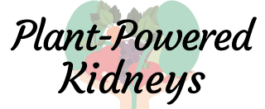
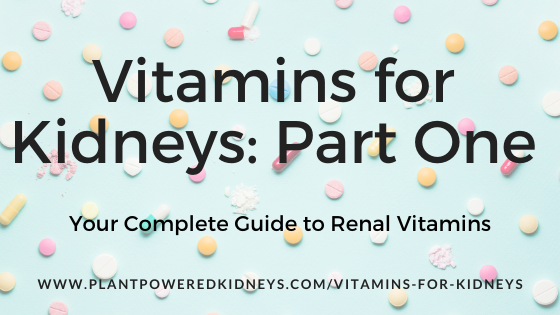
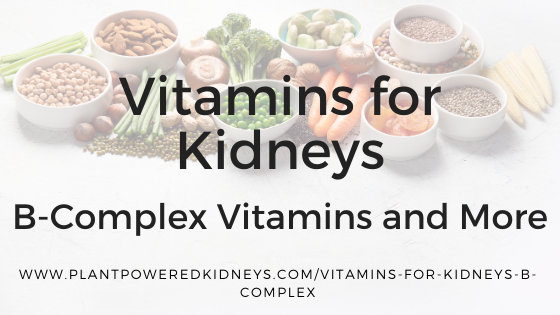
Thank you thank you for this printable list ! This will make grocery shopping sooooo much easier ! 🤓🌻🤓🌻
Yay! I’m so happy to hear that, Loretta! 🙂
How important is “raw” versus “cooked” vegetables? And, if you are allowed more than one serving of something, can you have 2 servings at one time?
In general, it’s mostly about the variety and what you enjoy. The way a vegetable is cooked can change the nutritional content. For example, boiling will remove some of the potassium, but a serving of cooked veggies is smaller than raw veggies. 1 cup raw or 1/2 cup cooked. As far as the servings per meal, that will depend. It’s not something I can speak to in general terms, unfortunately. I’d recommend asking your healthcare team or dietitian (and connect with one if you haven’t yet).
Hi, Jen!
Thanks for such a valuable article! My husband is at a GFR of 9 the past few months, and we’re trying very hard to keep him there or improve it. He is 83 and was diagnosed at Stage 3 about 17 years ago. He has not had to go on dialysis yet, because he demonstrates no symptoms of kidney failure and still feels well. He has some anemia, but not at the level you might expect. We eat a carefully planned, close to normal diet, and I spend a lot of time researching, as well as cooking!
I have more or less always ignored the nutrients in most seasonings, (except salt) since they are usually used in such small amounts, so I was amazed to read about thyme! High in iron and Vitamin C ! I use a lot of seasonings, especially garlic, which we know about, but I disregarded thyme, oregano, black pepper, and all the rest.
Please consider an article on just seasonings. I think it might help us all.
Thank you for your excellent articles, many of which I have copied to include in my “kidney notebook binder for reference.
Hi Mary Jane,
Thanks so much for your feedback. And it’s wonderful how much you’ve done to care for your husband. We do post content routinely on Facebook and Instagram, many times including information about different spices and seasonings. We’ll look into creating an article about seasonings as well. Thank you! – Jen 🙂
What advice would you give to patients who are trying to raise their iron levels, but have to watch their potassium (hyperkalemic)?
We love the Lucky Iron Fish for this! No potassium added, and it’s simple to add to foods or even water! 🤩
I was told that I cannot have liver, since it’s high in phosphorus. What kind of heme meat offers low phosphorous? As well as veggies? I know i.e. spinach is high in phosphorus. Any other suggestions? Thank u.
Check out our article about Low Phosphorus Foods or The Low Phosphorus Diet: What You Need to Know from a Renal Dietitian. Veggies are generally not a source of phosphorus (they’re usually a source of potassium though).
Pingback: Treatment Of Anemia - Iron Rich Foods for Kidney Disease - Foodche
Very useful information for those with kidney disease. Many thanks for sharing such a wealth of information…
I’m looking for foods that are high in iron and low in potassium. I’ve been anemic and have low energy but also potassium levels keep spiking. Tryingto minimize potassium intake
We also have our low potassium diet article available. You can “cross-reference” the two and find foods that fit your potassium needs but also provide more iron. You may also find searching our site for potassium to be helpful- we have a lot of content around this subject! 😉
Just a quick note to tell my experience with organ meats and gout!!
If suffering with gout or anticipating a gout attack do not eat organ meats. I had a terrible attack of gout from eating liverwurst.
Great point, Janet. Organ meats are generally high in purines and can cause gout issues. Have you read our article about it?